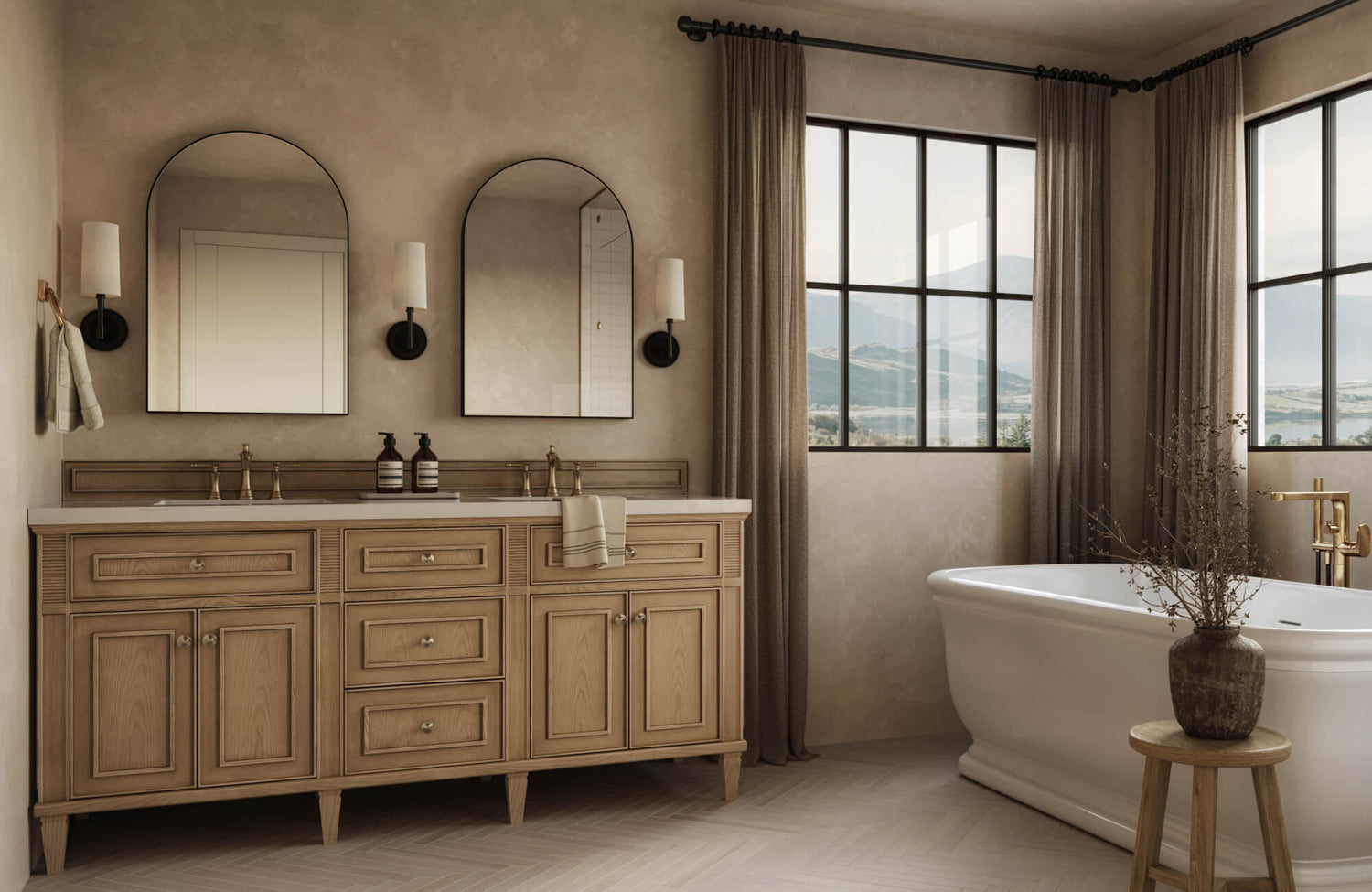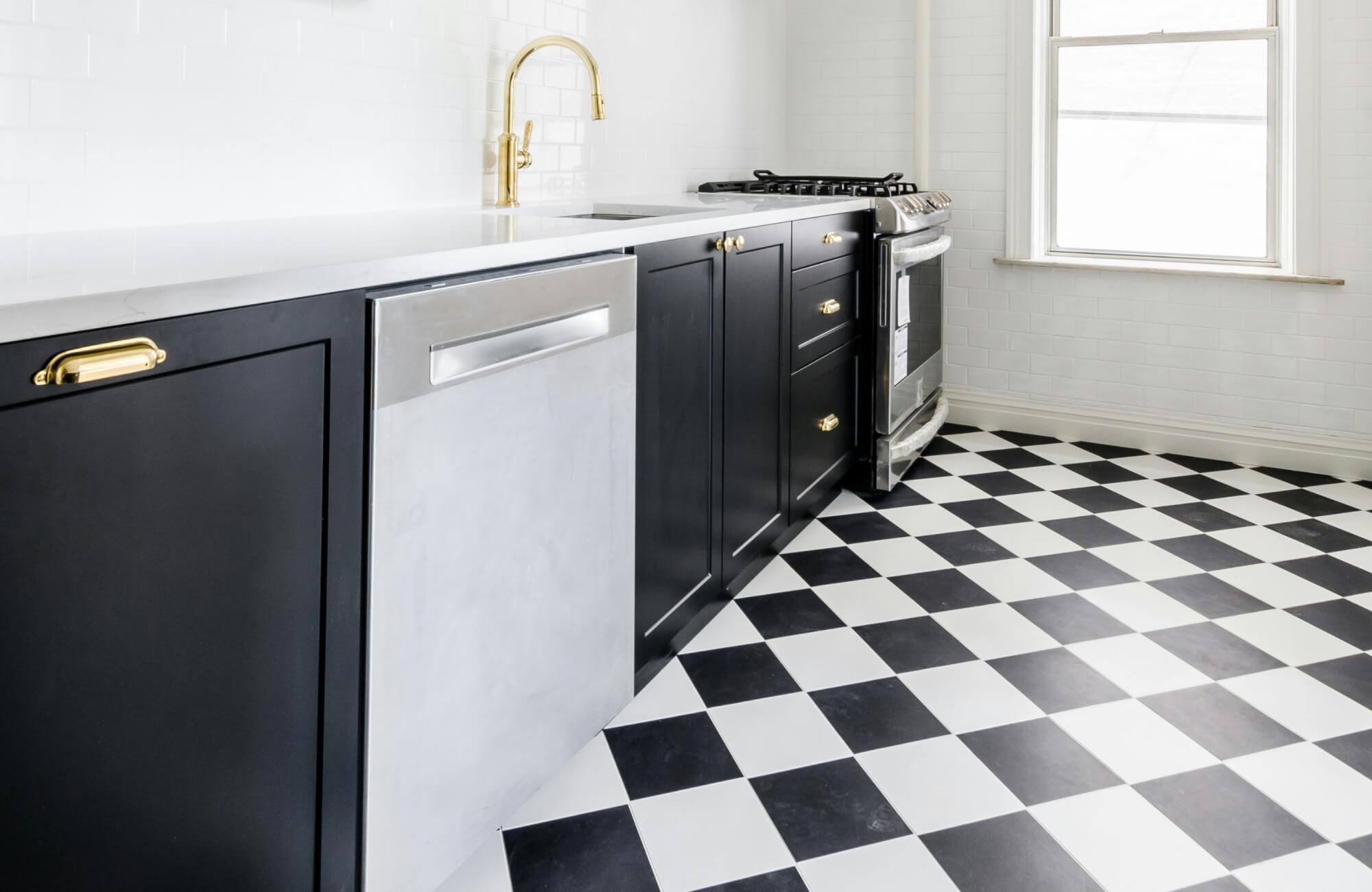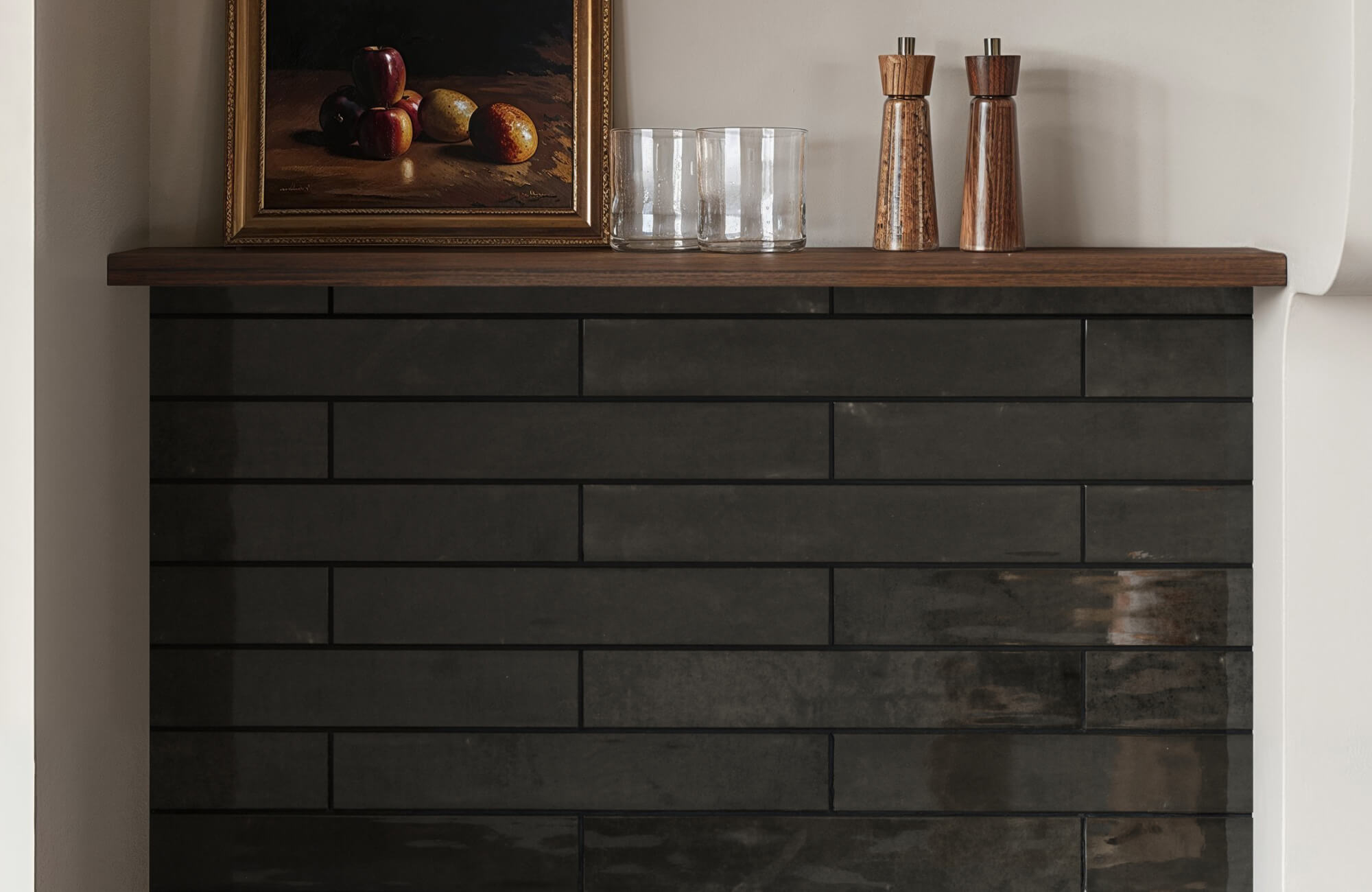When choosing the right tile for your bathroom, it's not just about how it looks, it’s also about how well it will hold up in one of the most moisture-prone areas of your home. In this article, we'll walk you through two standout options: ceramic and porcelain. Both tiles offer style and durability, but each comes with strengths depending on where and how you plan to use it. Whether you're refreshing a guest powder room or tackling a full bath renovation, understanding the unique qualities of these bathroom tiles will help you make the right choice for your space.

Ceramic Tiles Explained
When exploring tile options for your bathroom, ceramic stands out for its accessibility, creative potential, and ease of use. Discover how ceramic tiles are made, where they work best, and what to consider when weighing their pros and cons.
Features
Ceramic tiles are made from a blend of natural clays, shaped, dried, and fired in a kiln at temperatures usually below 1,650°F. This process resulted in a durable surface, though it’s a bit more porous compared to porcelain. However, once glazed, ceramic becomes significantly more resistant to water and stains, making it a solid choice for bathroom wall applications. One of ceramic’s biggest advantages is its design versatility, and manufacturers can produce an impressive range of colors, finishes, and textures. If you're looking to add creative or custom touches to your space, ceramic tiles offer plenty of design flexibility.
Where They Work Best
In bathroom settings, ceramic tiles work especially well on walls, vanities, and surfaces that don’t come into direct contact with water. They're an excellent choice for backsplashes, accent walls, and other decorative features that bring character to the space without needing heavy-duty performance. For shower floors or high-moisture zones, however, ceramic should only be used if it's specifically rated for wet areas. Their lighter weight also makes them a practical choice for upstairs bathrooms where minimizing structural load matters.
A great example of this application is Edward Martin’s Lilah 6x6 Glossy Ceramic Tile in Marine, as displayed in the photo above. Its rich, varied tones and reflective finish add depth and elegance to the bathroom wall, while still being appropriate for drier zones like the vanity backdrop. Ceramic tiles like Lilah demonstrate how ceramics can be practical and visually captivating when used with intention.
Pros:
- Easy to cut and shape, making it ideal for fitting around bathroom fixtures like sinks and mirrors
- Budget-friendly, allowing for stylish upgrades without overspending
- Comes in a wide range of finishes and colors to suit any bathroom design
Cons:
- More prone to cracking if heavy objects are dropped, especially on bathroom floors
- Can absorb moisture if unglazed, which may lead to long-term damage
- Not recommended for use inside showers or around tubs with constant water exposure
At Edward Martin, all ceramic tiles are glazed, which significantly enhances their water resistance and durability, making them well-suited for most bathroom applications. While ceramic tiles are typically recommended for wall and accent use, several Edward Martin ceramic styles are also rated for light floor applications, depending on the specific product’s specifications.

Porcelain Tiles Explained
If you're looking for a tile that can handle daily wear and constant moisture, porcelain is one of the most dependable options. Let’s explore what sets porcelain apart, where it performs best in the bathroom, and what to consider before making it part of your renovation.
Features
Porcelain tiles are made from ultra-fine clay and fired at higher temperatures, typically around 2,250°F. As a result, they’re denser, harder, and significantly less porous than ceramic tiles, making them exceptionally durable. One key feature is their low water absorption rate, which must be 0.5% or less to qualify as true porcelain. This characteristic makes them especially suitable for moisture-rich environments. Porcelain tiles are also available in two main types: glazed, which features a protective surface coating, and through-body, where the color and pattern continue throughout the entire tile. The latter is particularly advantageous in a busy bathroom, as it helps disguise chips and wear over time.
Where They Work Best
Porcelain is our top recommendation for bathroom areas that face constant moisture, including floors, wet rooms, and shower surrounds. Because of its low absorption rate and durability, it performs exceptionally well in spaces that demand resilience and water resistance. It’s also an excellent choice for ground-level bathrooms, especially when paired with radiant floor heating systems, as it retains warmth effectively. If you're aiming for a bathroom that blends long-term functionality with a high-end look, like realistic stone or wood look tile that stands the test of time, porcelain is a smart, stylish solution.
A great example is Edward Martin’s Shea 13.7x14.5 Matte Porcelain Wave Mosaic Tile in Cool Blend, as displayed in the photo above. Its soft, blended tones and wave-like pattern bring a sense of movement and calm to the space, while the matte finish adds subtle texture underfoot. Designed to handle moisture, porcelain tiles like Shea prove that you don’t have to compromise on style to get the durability a bathroom demands.
Pros:
- Offers excellent thermal stability, making it ideal for use with underfloor heating in bathrooms
- Resistant to stains and discoloration, which helps maintain a clean, fresh look over time
- Available in larger format sizes, allowing for a more seamless appearance with fewer grout lines, great for modern bathroom designs
Cons:
- Heavier than ceramic, which may require additional subfloor support or structural considerations in certain bathroom builds
- Limited color variation in through-body tiles, which can reduce visual depth compared to glazed finishes
- More difficult to drill through when installing bathroom fixtures or accessories, increasing the risk of breakage without proper tools
To meet a wide range of design preferences, Edward Martin offers an extensive collection of porcelain tiles that not only deliver on durability and moisture resistance but also bring visual richness to your space. Our offerings include tiles that mimic natural materials such as marble, wood, terrazzo, and onyx, along with a diverse palette of color variations and finishes. This versatility makes it easy to find the perfect porcelain tile for any bathroom style.

Choosing the Right Tile for Your Bathroom
Selecting the most suitable tile for your bathroom means thinking through the unique demands of the space, from constant moisture to daily use. To help you make an informed decision, we’ve broken down the key factors that can guide you toward the best tile that fits your bathroom.
Aesthetic Differences
Ceramic and porcelain bathroom tiles each bring their visual strengths to a space. Ceramic excels in color richness and surface variety, offering you a canvas for bold, playful, or highly personalized bathroom designs. Porcelain, on the other hand, shines in its ability to mimic natural materials. If you're going for the refined look of marble, limestone, or wood, without the maintenance, porcelain offers that level of realism in a more durable, water-resistant form.
A great example is Edward Martin’s Jameson 8x48 Matte Porcelain Tile in Camel, as displayed in the photo above. It captures the natural warmth and authentic texture of real wood while delivering the durability and moisture resistance that porcelain is known for, perfect for bathrooms where performance and style are essential. Tiles like Jameson highlight how porcelain can introduce the organic charm of wood into your bathroom without the maintenance, making it a smart, sophisticated choice for today’s modern designs.
To help you visualize how each option will look in your space, you can also use our augmented reality (AR) tool, which lets you preview tile styles directly within your bathroom environment before making a decision.
Installation Difficulty
One of the most noticeable differences between ceramic and porcelain tiles lies in how they’re installed. Ceramic bathroom tiles are generally easier to work with; they can be cut using a manual tile cutter and set with standard adhesives, making them a practical option for those taking on a DIY bathroom project. In contrast, porcelain bathroom tiles are much denser and harder, requiring a wet saw for precise cuts. Their weight and rigidity also demand greater care and experience during layout and placement.
For those unfamiliar with tile installation tools or techniques, working with porcelain can be challenging. To ensure a clean, long-lasting result, especially in a moisture-sensitive space like a bathroom, it’s always best to consult a professional installer who understands the nuances of each material. This extra step can also help prevent costly mistakes and ensure your tiles perform as expected for years.
Budget Considerations
When budgeting for bathroom tiles, it’s important to balance the upfront costs with long-term performance. Ceramic tiles are typically more budget-friendly, with prices ranging from $5 to $20 per square foot, depending on the design and finish. In addition, they’re less demanding in tools and installation, which can save you money if you plan to do the work yourself. This makes ceramic a great option if you're refreshing a guest bath or powder room on a tighter budget.
Porcelain tiles, on the other hand, typically start around $5 and can reach up to $30 per square foot, especially for premium styles that replicate the look of natural stone, such as the Aniston 24x48 Matte Porcelain Tile in Calacatta Quarzite. Although the upfront cost is higher, porcelain’s exceptional durability and water resistance make it a wise investment for bathrooms that see frequent moisture and daily use. Its long-lasting finish and minimal upkeep can easily outweigh the initial expense over time. As with any renovation, it's also important to look beyond the price tag and consider how well the material will perform in your specific bathroom environment.
Lifespan
When it comes to lifespan, both ceramic and porcelain tiles can offer lasting value in your bathroom, if installed and maintained correctly. Porcelain is known for its exceptional durability, often lasting 30 to 50 years without significant signs of wear. Its dense surface stands up well to everyday impact, moisture, and stains, making it ideal for busy areas like bathroom floors and shower surrounds.
Ceramic tiles also have a respectable lifespan, typically ranging from 20 to 30 years, particularly when used on walls, backsplashes, or other areas with minimal physical stress. While they may be more susceptible to chips or cracks if struck, especially in floor applications, proper installation can significantly extend their longevity. Ultimately, the placement of the tile and the conditions it’s exposed to will play a major role in how long it lasts in your bathroom.
Maintenance
Keeping your bathroom tiles in top condition doesn't have to be complicated, but using the right approach is key. Both ceramic and porcelain tiles are non-porous when glazed and are relatively easy to maintain. For daily cleaning, a mild, non-abrasive cleaner combined with warm water is usually all you need. This gentle method helps preserve the surface finish and prevents buildup, especially in humid bathroom environments. Avoid harsh or acidic chemicals, which can wear down the glaze over time and diminish the tile’s appearance. For more thorough cleaning, a pH-neutral cleaner is highly recommended, as it effectively lifts soap scum and stains without damaging the surface.
When it comes to tools, opt for soft sponges or microfiber cloths rather than abrasive scrubbers, particularly on glossy ceramic finishes. Scrubbing pads can create micro-scratches that dull the shine and make your tiles harder to clean over time. Additionally, remember that for the best results and to protect your tile warranty, it’s always important to follow the manufacturer’s care and maintenance guidelines specific to your ceramic or porcelain tile.
Grout Maintenance
Grout plays a crucial role in the appearance and durability of your bathroom tile installation. It fills the joints between tiles, keeping them securely in place while helping to block moisture from seeping behind the surface. In areas that experience regular water exposure, like shower floors, tub surrounds, and bathroom flooring, it’s important to choose a grout specifically rated for wet or high-humidity environments. This ensures it can withstand daily moisture without breaking down or becoming discolored over time.
To keep the grout looking clean and performing well, regular maintenance is essential. Use alkaline-based cleaners that are tough on buildup but gentle enough to preserve the grout’s structure. Avoid acidic cleaning products, which can weaken the grout and lead to crumbling or cracking. It's also helpful to gently scrub grout lines with a soft brush to remove any residue without damaging the surrounding tiles. And just like tile, always refer to the grout manufacturer’s guidelines regarding proper care and cleaning, especially when working with ceramic or porcelain tile installations.
Our Advice on Choosing Between Ceramic and Porcelain
In the end, the right choice comes down to how your bathroom functions and what matters most to you, whether it’s ease of installation, design versatility, or long-term durability. If you're leaning toward a more creative, budget-conscious, and DIY-friendly approach, ceramic tiles provide plenty of flexibility and character. On the other hand, if your bathroom sees daily use and requires a surface that can handle constant moisture and wear, porcelain tiles deliver both strength and sophistication.
To make the most of your investment, it’s important to align your tile choice with how and where it will be used. Choosing the right material for each area of your bathroom not only improves performance but also helps preserve the look and feel of your space over time. And if you’re still unsure which option is best for your project, don’t hesitate to contact us for expert advice; we’re here to help you find the perfect fit!
FAQs
Here are answers to frequently asked questions that can help you better understand the practical uses and differences between porcelain and ceramic tiles, so you can choose the right fit for your bathroom.
1. Can I mix ceramic and porcelain tiles in the same bathroom?
Yes, combining both can be a smart and stylish choice. For instance, ceramic tiles work beautifully on walls where design flexibility is key, while porcelain is ideal for floors with superior durability. Just make sure the finishes and colors complement each other to maintain a cohesive look.
2. Can ceramic or porcelain tiles be installed over existing tiles in a bathroom?
In some situations, yes. If the current tile surface is clean, level, and firmly bonded, new tiles can be installed directly over it using the right adhesive. Keep in mind, though, this will raise the floor height, which could impact thresholds, cabinetry, or plumbing fixtures. It’s best to consult a professional to determine whether this approach is suitable for your bathroom.
3. Can I use colored grout with ceramic or porcelain bathroom tiles?
Absolutely! Colored grout can enhance or contrast with your tile design for a more personalized look. Lighter grout shades can create a bright, open feel, while darker tones emphasize tile shapes and offer a bolder, more contemporary finish. Just ensure you’re using a grout rated for wet areas and resistant to staining.
4. Do ceramic or porcelain tiles fade over time in bathrooms with natural light?
High-quality ceramic and porcelain tiles are built to resist fading, even in bathrooms that receive plenty of sunlight. However, over many years, constant direct exposure can cause subtle shifts in color. To maintain their original appearance, consider tiles with UV-resistant finishes when designing bathrooms with large windows or skylights.
5. What tile edge finishes should I consider for bathrooms?
Edge style plays a big role in the overall finish. Porcelain tiles often feature rectified edges, which are precisely cut for a sharp, clean look and minimal grout lines. For ceramic tiles, rounded or glazed edges are ideal for walls and backsplashes, offering a softer finish. When planning transitions or accent areas, be sure to consider how these edge styles will work with trims and borders.








